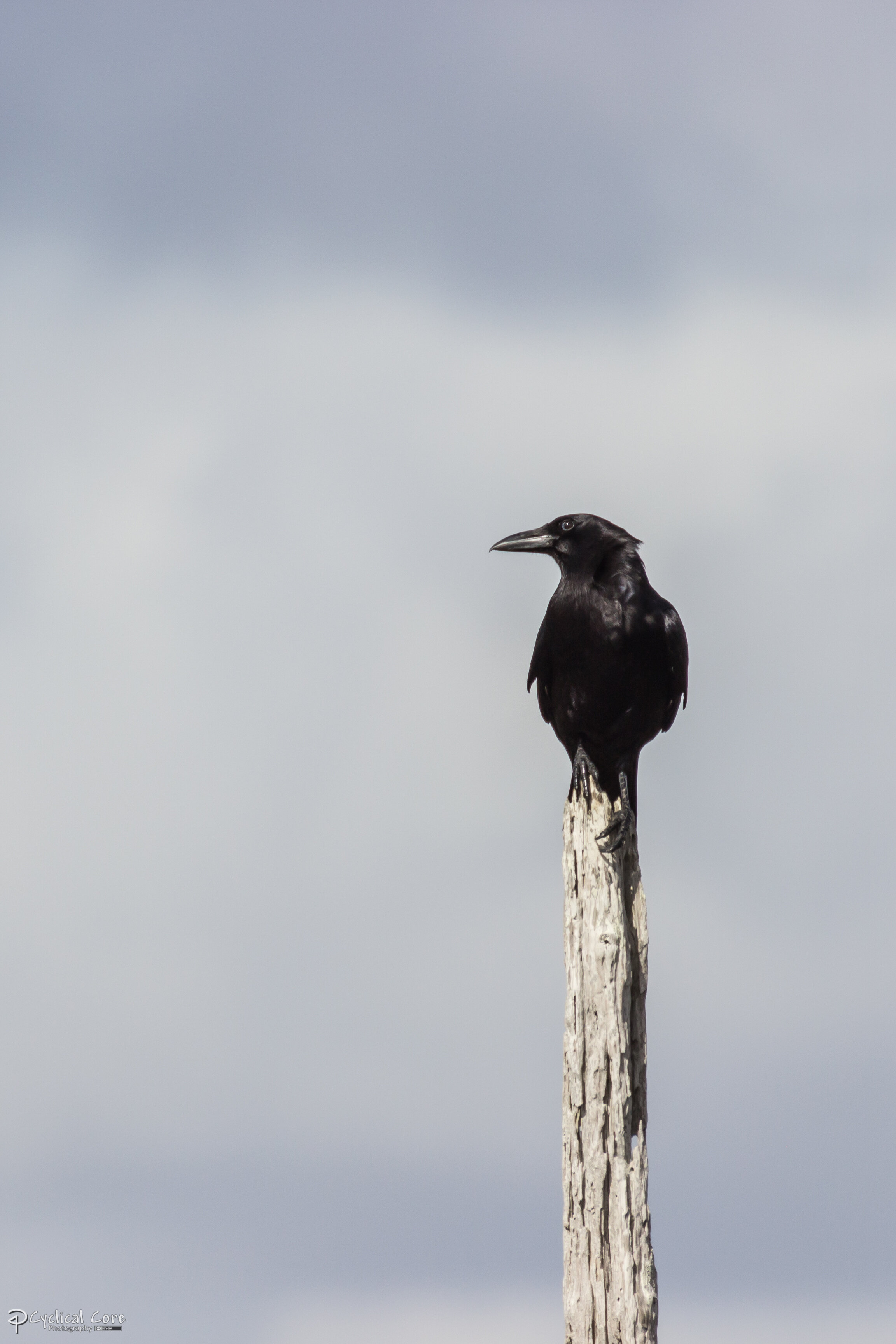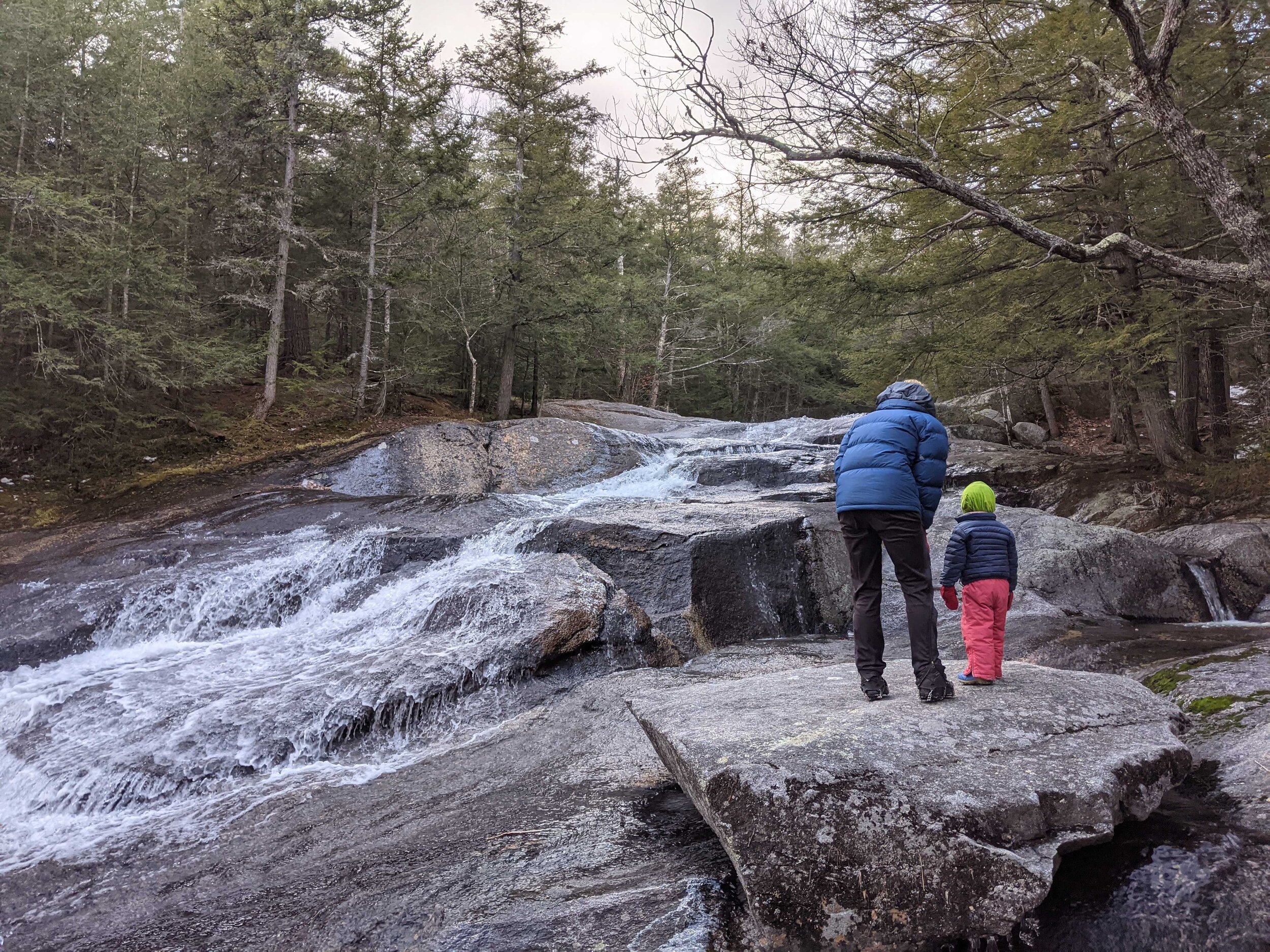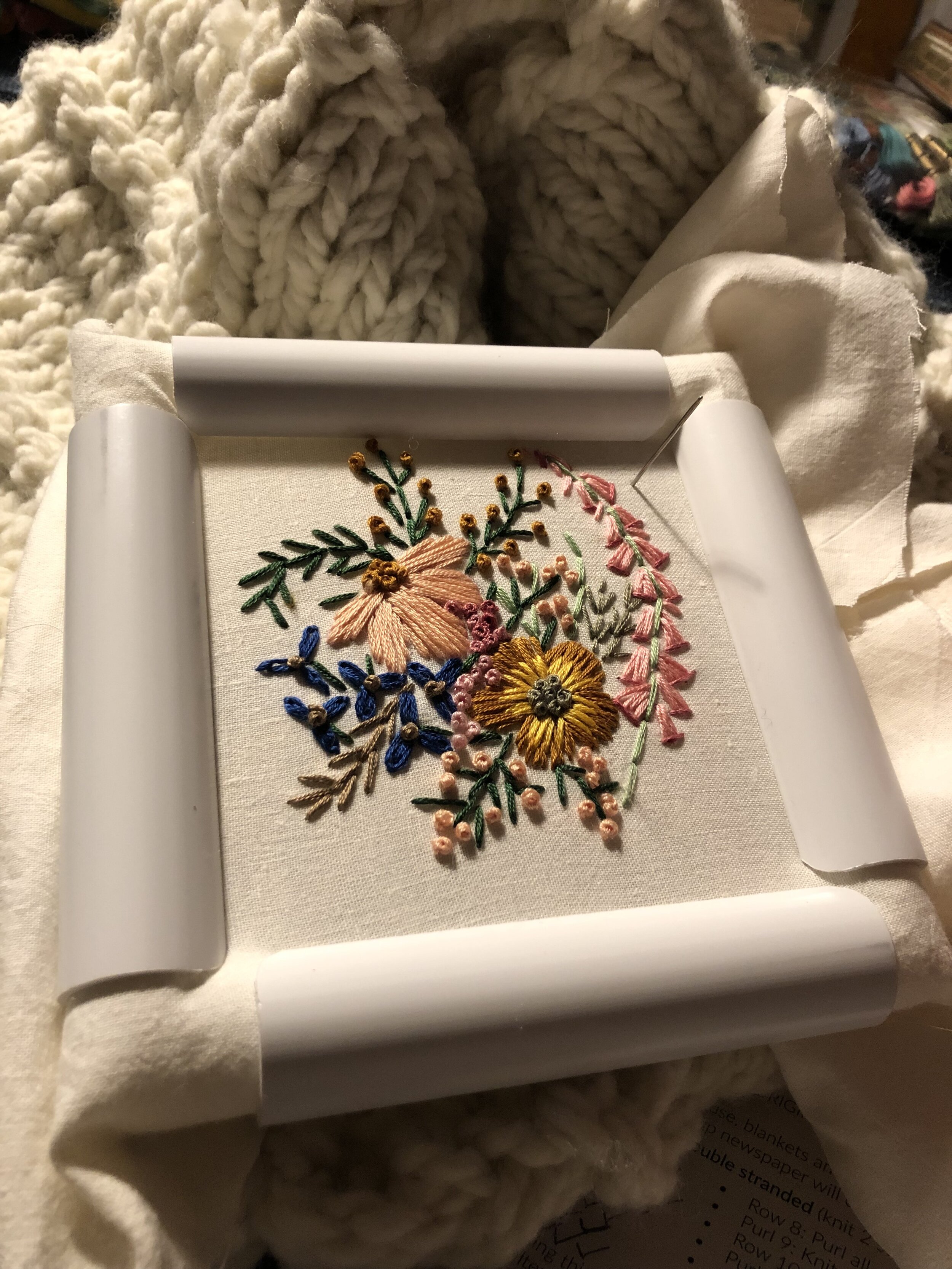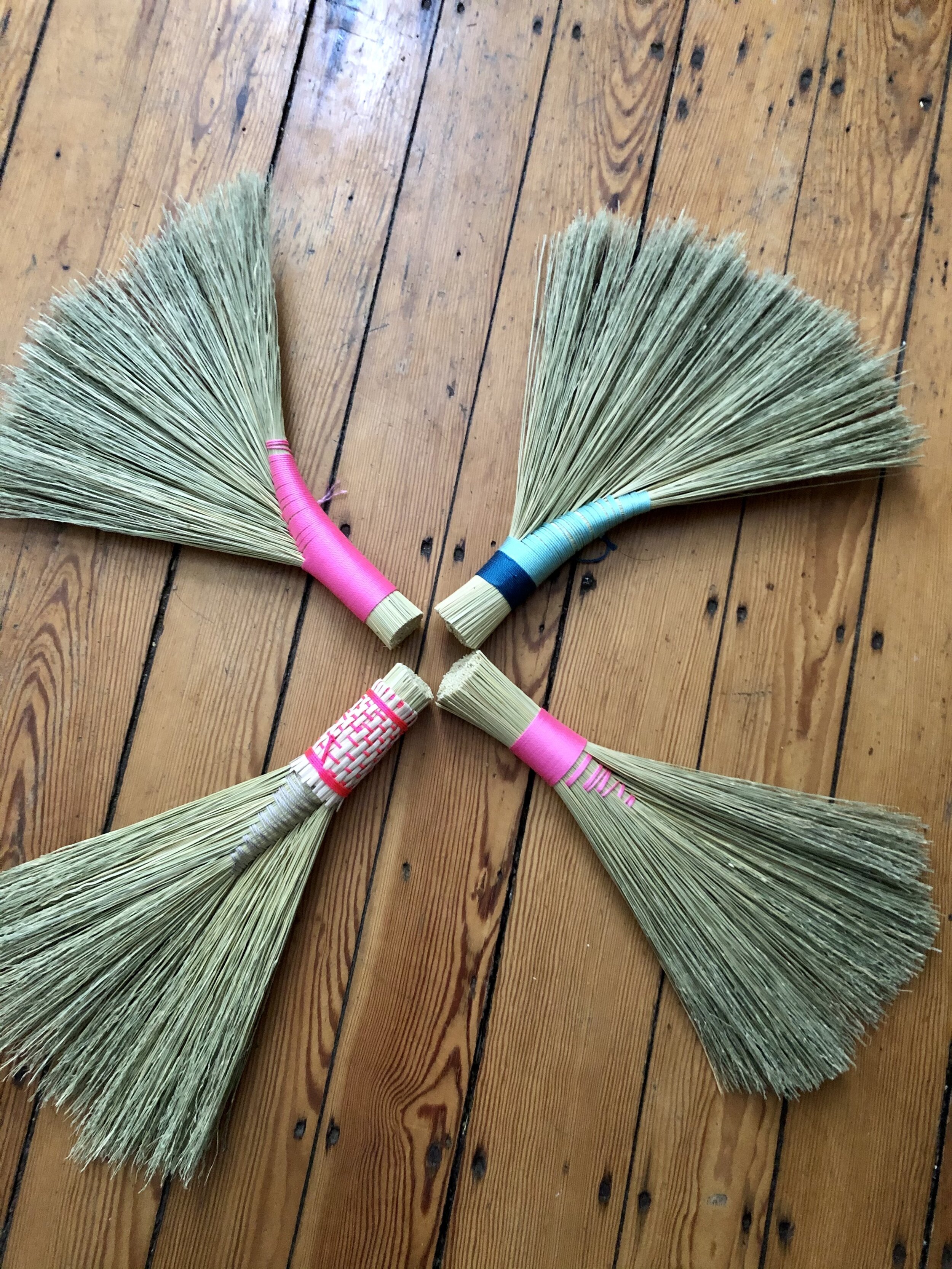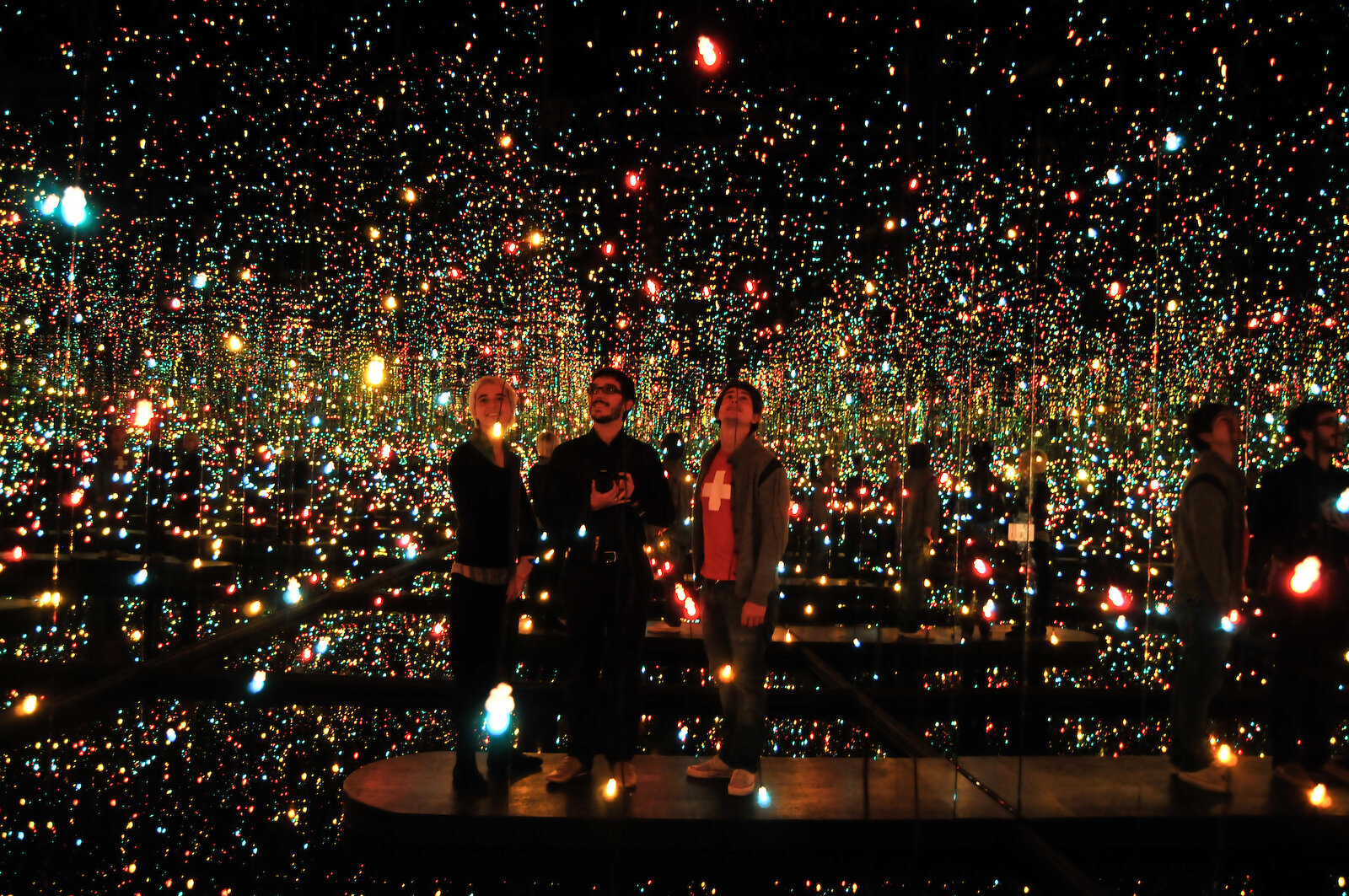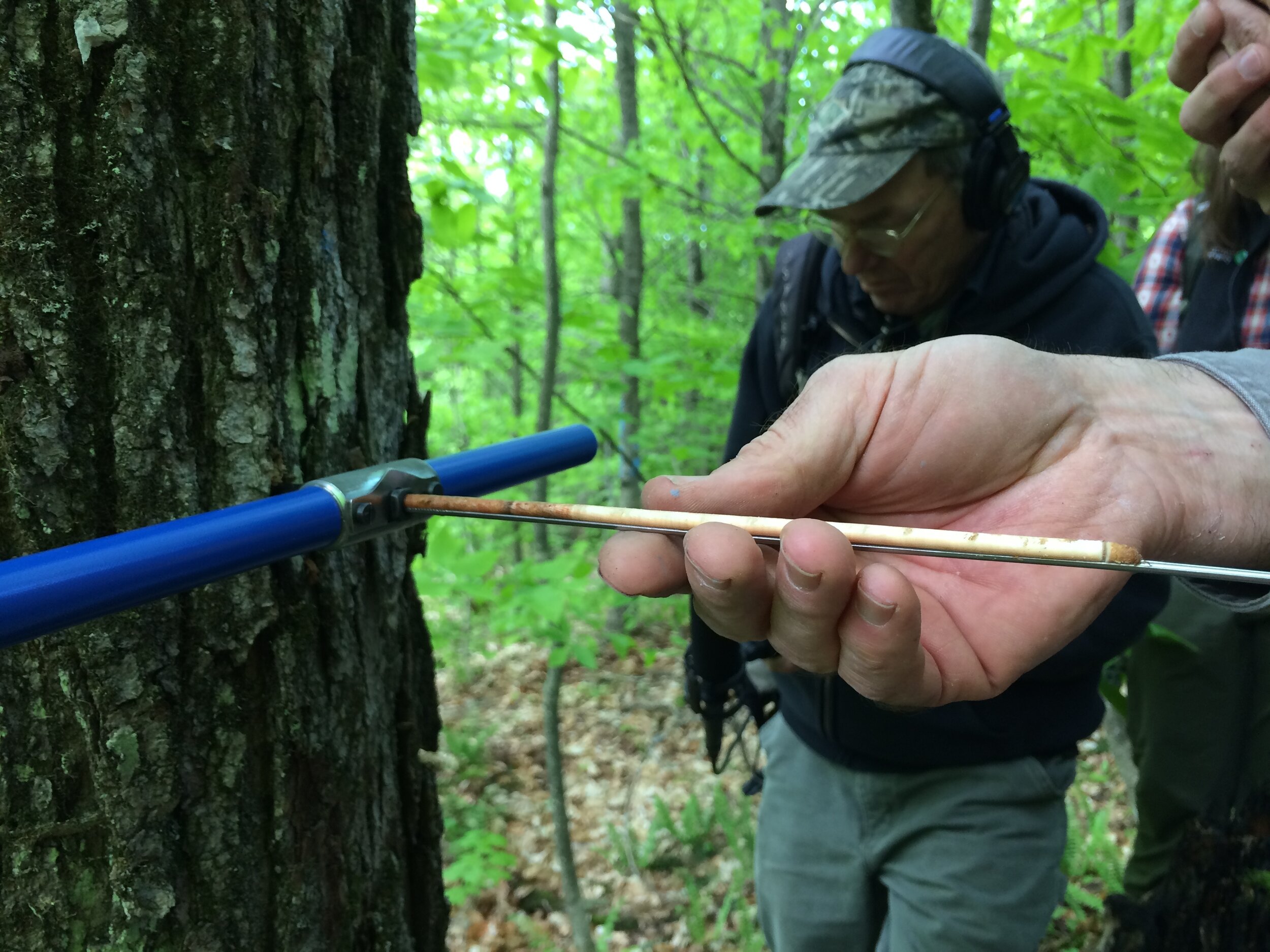Audio Transcript
Note: Episodes of Outside/In are made as pieces of audio, and some context and nuance may be lost on the page. Transcripts are generated using a combination of speech recognition software and human transcribers, and may contain errors.
Transcript: I Would Prefer Not To
[theme stem]
Sam Evans-Brown: This is Outside/In. I’m Sam Evans-Brown, with producer Justine Paradis.
Justine Paradis: And today, we’re starting with a tree - a tree with a name. Old Survivor.
Jenny Odell: oh yea, it’s funny, I was just over there the other day. So Old Survivor is the name of an old-growth redwood in the East Bay hills that is the single remaining old growth redwood, after these hills were logged.
Sam Evans-Brown: This is Jenny Odell. She’s an artist and writer - she teaches art at Stanford. Justine spoke with her about Old Survivor, a tree who Jenny has written about.
Jenny Odell: I mean, of course there are second and third growth redwoods. But that tree was not cut down because it was considered small by standards of redwoods at that time, which were huge, because they were old growth, and it’s also this strange twisted shape.
Sam Evans-Brown: Before Old Survivor was rediscovered in 1969, it was thought that all of the old growth trees in Oakland were gone. Also known as the Grandfather Tree, this redwood is around five-hundred-years old.
Justine Paradis: Old Survivor germinated before the Spanish invasion of South America... not long after Machu Picchu was completed in the Inca Empire, and just a few years before Queen Elizabeth I was coronated at Westminster Abbey.
Jenny writes about how it would have grown alongside generations of Ohlone people, living, growing old, dying... and in the 19th century, it would have kept growing, as grizzly bears, coho salmon, and California condors disappeared from the East Bay.
Jenny Odell: It's a witness. And what I find so amazing about that is… it's not abstract. That tree is the same tree. It has a physical aura about it, like you can put your hand on it and know that it's been living for that entire time.
Sam Evans-Brown: Old Survivor appears in the introduction of Jenny’s NYT best-selling book How to Do Nothing: Resisting the Attention Economy. The book is an exploration of how to withdraw our attention from the forces that would monetize it - like tech companies, for instance, but also work - and asks us to reexamine our participation in social media. Jenny is of course just one of many people examining these topics these days -- but one thing that sets her book apart is her exploration of nature in relationship with our attention, our time, and our productivity. And the way she draws inspiration from the likes of Old Survivor.
Justine Paradis: Jenny compares Old Survivor to a tree in a Taoist story attributed to the Chinese philosopher, Zhuang Zhou. In the story, a carpenter comes upon an old tree - it’s gnarled, and too big in the wrong ways, and he doesn’t cut it down because it’s not useful.
But later, the tree comes to him in a dream, and asks:
Jenny Odell: … who are you to call me useless? Kind of, useful for what? And my uselessness has been very useful to me because I have survived. And so the Old Survivor happens to be almost like, a real life version of the useless tree.
[harp]
Jenny Odell: I just find it to be such an inspiring example, not only of refusal and resistance, but existing in a way that’s at odds with the surrounding value system, so there’s obviously, that creates tension, but it may also be what helps you survive.
[mux rising, maybe stems/remix again]
Sam Evans-Brown: This is Outside/In, a show about the natural world and how we use it. I’m Sam Evans-Brown. Today’s show - a conversation with artist and writer Jenny Odell.
A lot of us may feel like our time and attention is not our own - and can easily disappear into the ether of work and the internet. But rather than merely suggesting a digital detox, in her book, Jenny Odell presents a third way. She draws on ecology, art, labor history, literature… and explores the seeking of a deeper kind of attention. An attention that probes our sense of selfhood, our relationship to place, time, and other species. An attention that reminds us - of our being animal on this planet.
Here’s producer Justine Paradis speaking with Jenny Odell.
[theme fade]
Justine Paradis: In 2016, Jenny had just moved to an apartment in Oakland, California. And she decided to make it a point to get to know her neighbors.
Jenny Odell: They have this… If I’m not in the living room, so they can’t see me, they will fly over on the roof corner that’s just outside my window and kind of stare at me. Like, where’s my snack?
Justine Paradis: Wait, like looking for you? Oh my god.
Jenny Odell: Yeah, haha.
Justine Paradis: These neighbors, by the way, are crows - who you can sometimes actually hear in the background of her recording.
Jenny had learned that crows can come to recognize human faces, and they’re intelligent, you know, by human standards of intelligence.
Justine Paradis: Four years is a while to be friends with a bird.
Jenny Odell: Yeah. I mean and it's funny to think about that first year. I couldn’t even get that to stop here. And then it was a really big deal when they landed on the balcony. That took a really long time. And then now we have this wooden bowl that has rocks and pine cones and stuff in it, and I started hiding a peanut in there. And they seem to really enjoy that, but that's on the table, like really close to the door. Then there was one day where they took the peanut from somewhere else and they put in the bowl, which was very confusing to me. I was like, this is backwards. And now it's an advanced game where I put peanuts under a small silver bowl that’s upside down in the bigger bowl.
Justine Paradis: Oh my god.
Jenny Odell: And they're very into that.
Justine Paradis: This was again, in 2016, and by the end of that year, Donald Trump had been elected president. It was a high-anxiety moment for a lot of people, including Jenny - and she was in a dark place in her relationship particularly with social media -
Jenny Odell: You know, caught in a loop of urgency and reaction, what we would now call doomscrolling. I don't know if we had that term at the time. And just a very kind of claustrophobic way of being, it felt like? And to just look at them, and sort of see myself from their perspective, was so therapeutic to me at the time. It was like, being reminded that I am an animal, and that is being viewed by another animal, that itself has a completely different understanding probably of space and time, and what even ‘a place’ means. Right? Like, I think a lot about what this hill looks like to them. It’s a completely different map.
Justine Paradis: Around the same period, Jenny also found herself spending a lot of time in the Rose Garden in Oakland, a spot just five minutes from her house officially called the Morcom Amphitheater of Roses.
Jenny Odell: It’s a little bit unusual because it’s got a very sort of labyrinthine quality and it’s very close to a lot of more urban-feeling stuff… so it’s kind of a little pocket hidden away. And so I was going there, and kind of sitting, and “doing nothing.” And then inevitably started thinking about why….
Justine Paradis: Being there, she told me, felt instinctual. Plus, around that time, there was also the Ghost Ship fire in Oakland, a disaster at a warehouse in which dozens of people died.
Jenny Odell: A lot of artists, friends of friends, passed away in that fire.
Justine Paradis: It was at a concert right?
Jenny Odell: Yeah, it was a show, like an underground show. And so it was just a lot to deal with at that time. For me one of the most important parts of not trying to do something, these things that you notice, they kind of flood in.
[beat]
So, one of the things that became noticeable to me was the importance of a space like that. A space where you are not a customer. You're not a performer. You know, you're just a visitor, and there's something about things like public parks and libraries that to me are very inspiring in terms of spaces of recuperation but also inspiration, and fellow feeling with humans and nonhumans.
Justine Paradis: As Jenny was starting to get to know the crows and trying not to doomscroll, she was also invited to give a talk at a conference called EYEO, which exists kind of at the border of art and technology. This talk eventually became the first chapter of her book, and it started from that question she’d been asking herself as in the Rose Garden: why did nothing feel so necessary? What did she even mean by “nothing”?
Jenny Odell: I mean, nothing is a complicated word already, by itself. And I kind of tried to set up early in the book: that my nothing only appears as nothing from a certain point of view, and that point of view would be one in which productivity sort of equals work-output-per-unit-of-time maybe, or capitalism-informed notions of what progress and growth mean… and so that kind of view of progress and productivity would tend to see a lot of the types of activities and attention that I’m advocating for as nothing, because we don't produce anything and often I think also are maybe difficult to commodify, difficult to verbalize. To use a kind of dumb example, it’s something that’s uninstagrammable, right? It’s like, you just experienced it, and then it was gone, and you don’t “have anything to show for it,” even though to me those are some of the most meaningful moments in life. So, yeah. By nothing, it’s sort of tongue-in-cheek, it’s obviously not nothing to me.
Justine Paradis: One thing I really appreciate about Jenny’s book is that it’s not prescriptive. She’s not telling you specifically and definitively what nothing is, or despite the title, how to do nothing exactly. But in other interviews, she’s said that going on a walk is maybe the representative example. Approached a certain way, a walk doesn’t have a purpose. The goal of a walk isn’t to finish the walk - being on the walk is an end in and of itself. How could a walk be “efficient”? Often, you’re choosing the least efficient path, the most wandering and circuitous.
And then, as for “attention” -
Jenny Odell: I remain endlessly fascinated with how much there is to notice and that’s kind of the artist in me talking a little bit, but I think that we've all had experiences where something or someone pointed something out to us that was right in front of us and then it’s life changing, because then you notice it for the rest of your life. That's happened for me with birds, right? The idea that before 2016, I was pointing my eyes at all of these very same birds, probably, and I’m not sure what I saw. I probably just saw "birds" or I didn’t see anything at all. That’s kind of mindblowing to me.
[mux]
So it's for me it's tied to choice, and direction, so you can choose to direct your attention, including you can choose to try to notice what you haven't noticed, which I think is the most important form of that.
Justine Paradis: Social media is a good example in your book. Like, these days the science of our attention is really well-studied and sort of employed to our disadvantage, specifically on social media, which takes advantage of our psychology, our need for dopamine hits. So, withdrawing your attention and resisting the attention economy feels like it's a skill, like something we almost need to be trained in, but it also feels so monumental. But I also want to point out that this line of thinking can also feel kind of basic. Like, you know, social media is rotting the millennial brains, and “the kids these days,” but your book goes a lot further than that. You're not saying buy some land, retreat, turn on, tune in, drop out, right?
Jenny Odell: Yeah, absolutely. The idea of a social media is not something that I have a problem with, and I would consider predigital things like gossip to be a form of social network. You know, there's nothing wrong with wanting to be connected to other people and share information. That seems like a very basic human thing to me. Or even wanting to share entertaining things with your friends, right? To me, the problem arises pretty specifically from the structure of the mainstream social media platforms that we do use, where certain type of expression are favored and then that really has a snowball effect, on top of, as you mention, this kind of really nefarious attention on their part to how psychology works, and how to keep a user on a platform as much as possible.
Justine Paradis: The infinite scroll is one of these techniques. There’s no bottom - there’s always more to see. Eye-catching notifications and videos that automatically start to play as you try to pass by. Like a slot machine at a casino, researchers have found that these stimuli literally trigger the same parts of the brain as an addictive substance.
So it’s like these kinds of structural things about commercialized social media I have a problem with.
[mux]
I think it's a little bit unreasonable to stop paying a certain type of attention without suggesting another type of attention. So, for me, I think - i started paying attention to ecology, specifically to birds, and that is so absorbing to me that it's addictive in its own way, and so it's not like I suddenly gained this ability to not be absorbed in anything. It’s that I was able to find something that made me feel more, kind of, in the world rather than out of it and that was also was kind of able to help me break out of these cycles of anxiety and despair, and these kind of feelings that are really driving the attention economy.
Justine Paradis: Yeah, I mean, one thing that you have said is that a reason to do nothing is that “it’s a reminder that you're alive.” So I feel one thing the book does is sort of explain why it's important to withdraw your attention, and what it means for our collective life as well as our individual life. Nature and ecology feel like one of the means to do that and perhaps a critical one. But I wonder if you can explain what is the importance of nature and ecology in withdrawing attention, or retraining it?
Jenny Odell: I think, for me, in the book, it sort of functions as both a metaphor and as a subject, and as content. Like I think as a metaphor, ecology is really useful for me in thinking about context. The role of context. So, you can't look at any supposed entity in ecology without starting to notice how interconnected it is with so many other things, right? Like one of my favorite examples is the way fungus interacts with trees, and at the point of contact, sometimes the fungal bits are almost in the tree. It’s very hard to separate them, even functionally. You know, and I mention in the book, I'm biracial and so I like thinking about in-between zones or things like atmospheric rivers that bring water from the Philippines to where I am. And it just really, I think it teaches you how to think about and appreciate complexity, and really sit with that, which to me the opposite of how information circulates on social media. So that’s the metaphor part of it, but I think just as a subject, of looking… I don’t know, maybe not everyone feels this way, but I think you can just pick anything and look at it and you just pretty soon get bowled over by how strange and amazing it is.
I mean yesterday, I was reading a book, actually I was reading a book about quantum physics, for someone who doesn't know anything about it, and was having my mind blown in that way, and then this bee came over to where I was sitting, like one of those really big bumble bees. And this bench I was sitting at happened, it’s very kind of ensconced in a plant.
[mux/sound design]
My point being: the bee is right next to me and it was just kind of making the rounds of this plant. And I was like in bee universe for a while. I was looking at its eyes, and then I realized I had never looked at the flowers on that plant, because, I don’t know, it doesn't look like that interesting of a plant, but when you see it from the perspective of a bee, it looks completely different.
Justine Paradis: Jenny grew up around San Francisco - actually, in Cupertino, where the Apple campus is now located, and How to Do Nothing is specifically rooted in the Bay Area, and engaging with the idea of become a citizen in one’s place ---
Jenny Odell: For me, I think it’s familiarity, just like with a person. It’s a familiarity with the character of a place. And I think my reading of it is informed by what I talk about in the book, the experience of growing up in the Bay Area without knowing it, without knowing what the Bay Area is, until basically right before I wrote this book
Justine Paradis: As Jenny got to know the nature of the Bay Area she writes about an experience that I think many of us half felt: that a connection with nature can bring a welcome sense of our own smallness, our own membership in a community that is bigger than human and bigger than this time.
Jenny Odell: ...so the landscape is a community, it has these relationships, and you are a member of that community. And you have responsibility to that community.
Justine Paradis: Where a profile on social media centers the user, nature breaks down the idea of an individual self, of a species, of human constructions.
Jenny Odell: My favored version of bioregionalism is one that actually makes the notion of boundaries and borders absurd.
[mux begin]
I think that's what you see with tree roots and the fungus, but also things like weather and migration, successional stages, right? There’s a place I really like to hike that has a bunch of bay trees and manzanita and there’s a really lovely sign that basically tells you, if you come back in 100 years, it's not going to look like this. Because there are stages! Right? In these places, nothing is frozen. And so that’s, when you observe the character of a place, it's always a moment in time.
Justine Paradis: In a way, an engagement with the local ecosystem is a reframing device: a mechanism that makes it possible to notice something we haven’t noticed before, to literally see something from a different perspective.
Like, for instance, when Jenny decided to reacquaint herself with the Calabazas Creek, which was one of those things that had kind of existed in the background for her growing up, she decided to visit it at different points along its journey, leaving the channels in which people move, like the sidewalk and the street, and following it where it had been directed in a concrete channel, and where it flowed behind a strip mall.
Jenny Odell: And I remember looking up out of the creek and just seeing the back of the Bank of America.
And, almost like looking at the back of a piece of embroidery, she saw her hometown from the water’s point of view.
But this is just one of many reframing devices.
Justine Paradis: Nature is just one of the tools that you talk about… and you turn a lot to art. I wonder if you can talk about John Cage, who is the composer most famous for 4’33” which brings audiences into a music hall and seats them for four minutes of silence. And is almost sort of like made a joke of, like here’s this contemporary art gimmick. But how do you see John Cage?
Jenny Odell: Yeah, it is very easy to see the piece that way. And I should add that I think he had a very good sense of humor.
Justine Paradis: That’s good to hear!
Jenny Odell: Yeah there’s a playfulness irony in his work, which I really love. But, yeah, I feel like John Cage is for me is, on the level of sound, one of the best examples of how an artist can create an architecture of attention, so they can set up these kind of parameters, and conditions, in which you, the listener or the participant, will hear sounds or notice sounds that you would not have otherwise. And so, my personal experience of that was going to see a John Cage piece performed at the San Francisco Symphony piece. It wasn’t 4'33". It was a composition, that involved 3 vocalists, all dressed in plain clothes, which was really strange to see at the Symphony, and the score had lots of chance operations in it. So the liner notes said: this will last anywhere from 15-30 minutes, depending on what happens and there was lots of things like shuffling cards, the director making a milkshake in a blender, you know, just all kinds of interesting sounds being considered as part of this musical composition.
And it had two really interesting effects on me. One, was to notice things about the Symphony Hall that I hadn't noticed before. Like, usually musicians wear black. Usually people in the audience don't laugh. And it highlighted the whole structure of performance itself. And then I walked outside, and I just realized that I could hear everything better, or I could hear some things probably for the first time. This whole composition going all the time: the buses, people walking, and you know, just everything that's been going on this whole time that I did not have access to, perceptually. So, I don't think I ever heard anything the same way after that, and it sounds like an exaggeration, but it’s not. It permanently changed the way that I hear things. And that’s one of the reasons that I find that kind of art to be so generous. Because I think it puts new things in the world for you, and it makes your experience richer, and it gives you more access to the things that are around you.
Sam Evans-Brown: More from Jenny Odell - when Outside/In continues.
BREAK
Sam Evans-Brown: This is Outside/In, a show about the natural world and how we use it. I’m Sam Evans-Brown, and today on the show, a conversation with Jenny Odell, artist and author of How to Do Nothing: Resisting the Attention Economy.
For Jenny, engaging with place and ecology also meant taking on a responsibility to that place. She wrote, “It’s important for me to link my critique of the attention economy to the promise of bioregional awareness because I believe that capitalism, colonialist thinking, loneliness, and an abusive stance toward the environment all coproduce one another.”
Here’s Justine Paradis.
//
Justine Paradis: The idea of an eight-hour work day is the product of a labor movement, beginning in the mid-1800s. It advanced the radical idea that people deserve 8 hours to work, 8 hours to rest, and 8 hours for “what you will.”
Jenny quotes Samuel Gompers, a 19th century labor group leader, who, sidenote was also pretty racist . Gompers wrote, “What does labor want? It wants the earth and the fullness thereof.”
But the eight-hour work day is far from universal. I would say it is not an ideal honored by contemporary work culture: the gig economy can turn any available minute to a potential earning opportunity. Performance-based jobs reward productivity and even punish the lack thereof. And meanwhile, work emails ping their way into dinnertime -- social media might be a way to connect with friends but it becomes, unwittingly or not, a personal brand - and ideals of self-optimization can make even meditation competitive.
In this culture, Jenny writes, “Attention may be the last thing we have left to withdraw.”
Justine Paradis: You point to a couple examples of people, both real people from history, whether they’re mythologized a little bit, but also fictional characters who have refused. I think one of my favorite moments was when you talked about Bartleby the Scrivener… how did Bartleby refuse? Can you tell the story about Bartleby?
Jenny Odell: Sure. So Bartleby is the character of the Melville short story “Bartleby the Scrivener” who is famous for saying “I would prefer not to.” I actually have a tote bag that says “I would prefer not to.”
Justine Paradis: Ha! He was monetized!
Jenny Odell: That’s Melville House’s tote bag, and they’re my publisher. And I actually was wearing it on a walk and this woman was driving by and she rolled down her window and she was like, “Bartleby!” So clearly, people associate Bartleby with this phrase, as they should.
But, uh, Bartleby is a copyist, who is asked to copy something by his boss, and keeps saying, “I would prefer not to,” and there’s never really an explanation. And it's told from the point of view of the boss, who is just completely perplexed. And the thing I find so magical about that phrase is: it's not, "I won't." It's not “I will” and it’s not “I won’t.” It’s, “I would prefer not to.”
[mux]
And I think it’s worth noting that the boss was not asking about his preference. Like his preference was not a part of the equation. So, not only is he not doing it, he's also completely refusing the terms of the question, which I think is a much wider form of refusal, and is so helpful as a sort of model of engagement or disengagement, whatever you want to call it.
Justine Paradis: an important word for you is resist, in the title. And you really tie this history of doing nothing to a history of labor and work and the commodification not only of our spaces, but of our time and our days. Can you talk about why resistance and refusal is tied to the reclaiming of attention?
Jenny Odell: I mean, I just see it as a kind of preliminary step that leads to other forms of action, so I would never say that “doing nothing” as I’m describing it in the book is itself activism, for example. I think I describe it at some point as a waystation on the way there. I like to think about this kind of initial step of unlinking one’s own forms of thinking and value from the sort of capitalist ether and the culture of personal branding and optimization, as like, again, a first step that might then allow you to notice different kinds of things, notice different actors in your environment, maybe begin to seek more context, and reach out and form different kinds of networks that feel more intentional, or to simply just rest, right? Which, I think a lot of people are just denied rest. And I think the tricky thing is, on the one hand, I find that promising, and I think I am addressing an individual within the space that they have to redirect their attention, at the same time that I have to acknowledge that not everyone has the same amount of that space or kind of that space. Like, I don't want to fall into the self-help bucket of like, just do it, right?
Justine Paradis: Just do nothing!
Jenny Odell: Just do nothing, right? It’s like, that’s not possible.
Justine Paradis: I mean, I feel like there's kind of a caricature of how this idea could be used, with the disillusioned tech founder who has inventor's remorse who discovers meditation, and says ‘use mindfulness to self-optimize’ at his retreat center. It’s like, almost any of these ideas can be kind of just taken, and then rebranded or monetized.
Jenny Odell: Oh yeah, believe me, I know.
Justine Paradis: Like, forest bathing retreats or something.
Jenny Odell: Yeah, and I was honestly biting my nails when the book came out because it’s so ripe for that, right? And I think maybe one of the things that would resist that, maybe, is that I think I put a lot of emphasis in the book on both gathering context and humility cuz I see those as combined. You know, to seek context on something is to admit that you don't know the whole story. You need more information. You're not sure. You need the expertise of people who have come before you… you know, whether that's simply the history of activism in your area, or simply ways that you have been complicit in something without realizing it. It’s kind of like, again, it’s the thing that has been right in front of you the whole time kind of dynamic. And then sort of with that same humility, asking, what can I do to be of support? How can I fit into this? How can I be useful? I say useful, useful in a different way than a useful tree. But, yeah, for me I think there's a big difference between that and being like, "I just discovered meditation."
Justine Paradis: Who has the time and luxury to say, I would prefer not to?
Jenny Odell: I can't speak for other people...I have the experience that I have. One book that I was really struck by last year was On the Clock by Emily Gwendolsburger - where she works at an Amazon fulfillment center, a call center and a McDonalds, kind of similar to Nickel and Dimed. I really recommend that book, because that will show you this horrible calculus of survival, not just being worked extremely hard on job, but then the commute, and trying to rest enough to be able to do that job. That's a situation with little to no temporal autonomy. No time. I would imagine not a lot of attention to spare. And I do also find it really inspiring, the examples she gives in that book, of ways that - even though people are not allowed to talk to each other on the warehouse floor, for example, the little ways people find around that. Or you know, she sneaks in ear pods one day, so that she can listen to something, right? So anyway, I would point to things like that that are more informed about that kind of life experience than mine.
Justine Paradis: In the book, Jenny’s Rose Garden is both a literal example of the kind of space we need to do nothing and a metaphor for the space we need on a more psychological and sociological level. It’s an example of a kind of space where a person can just exist - not as a worker or performer, or as a customer, user, or audience member - where you don’t have to buy something to feel like you have the right to be there.
These spaces are increasingly rare and under threat. Both the literal ones, like libraries and parks, and more abstractly, things like free time. The right to fall asleep in public.
Take even stopping to look at a bird in the public space of a sidewalk - not too unusual, but not ‘not unusual’ either. You might be standing still, tilted head, staring off into space. Maybe you’re peering into a bush.
But this kind of behavior can get people into trouble, some people more than others. Think about Christian Cooper, the Black birder in Central Park, when a white woman called the police on him after he asked her to leash her dog.
In fact, saying “I would prefer not to” arguably doesn’t even work out for Bartleby. I’m gonna tell you how the story ends - his boss is so dumbfounded by his refusal that he ends up moving offices. Bartleby takes up residence there, but when the new tenants move in, eventually, he’s jailed, and he dies in prison.
[mux]
Personally, I read “I would prefer not to” as another example of a reframing device, like John Cage or viewing the neighborhood from the point of view of a creek.
Jenny Odell: The 'I would prefer not to" kind of approach for me is to just a) be very aware of oneself, you know, and that platform, and the ways it's working up on you and working upon your reactions… things like anger, and shame, and loneliness, these are things that very quickly can fuel your interactions with social media...
The other part of it is kind of taking the center of gravity, and moving it out of that and into the world around you, and these kind of more specific, context-filled connections that you have with people, or with a place, with other beings. That that is, for me, that is what will anchor you. I’m suspicious of digital detox rhetoric for so many reasons but that’s one of them. I think if you want to truly shift your relationship- it’s going to have to be about something bigger than that.
[music]
Justine Paradis: In the introduction of How to Do Nothing, Jenny reflects on the story of Old Survivor, the 500-year-old redwood in Oakland, and the Taoist story of the useless tree, writing:
“The shape of the useless tree does more than just protect it from the carpenter; it is also the shape of care, of branching out over the thousands of animals who seek shelter, thus providing the grounds for life itself. I want to imagine a whole forest of useless trees, branches densely interwoven, providing an impenetrable habitat for birds, snakes, lizards, squirrels, insects, fungi, and lichen. And eventually, through his generous, shaded, and useless environment might come a weary traveler from the land of usefulness, a carpenter who has laid down his tools. Maybe after a bit of dazed wandering, he might take a cue from the animals and have a seat beneath an oak tree. Maybe, for the first time ever, he’d take a nap.”
END
Sam Evans-Brown: That was writer and artist Jenny Odell, author of How to Do Nothing: Resisting the Attention Economy, which came out in paperback in December 2020.
This episode of Outside/In was produced by Justine Paradis, with Taylor Quimby and me, Sam Evans-Brown.
Erika Janik is our executive producer.
Maureen McMurray is Director of Pond Skating.
Music from Blue Dot Session
Theme is Breakmaster Cylinder
Outside/In is a production of New Hampshire Public Radio.
Justine Paradis: Do they ever bring you things?
Jenny Odell: They have not brought me anything except one time I wrapped a peanut in some foil, just to see if they could get it out, and they did, and they made it the foil into a little ball and they put it in the bowl.
Justine Paradis: oh!
Jenny Odell: And I was like, how polite! Thank you.


